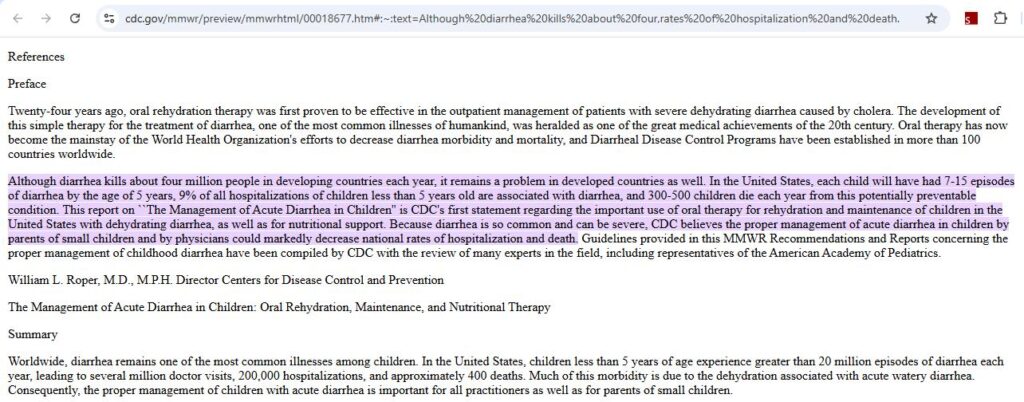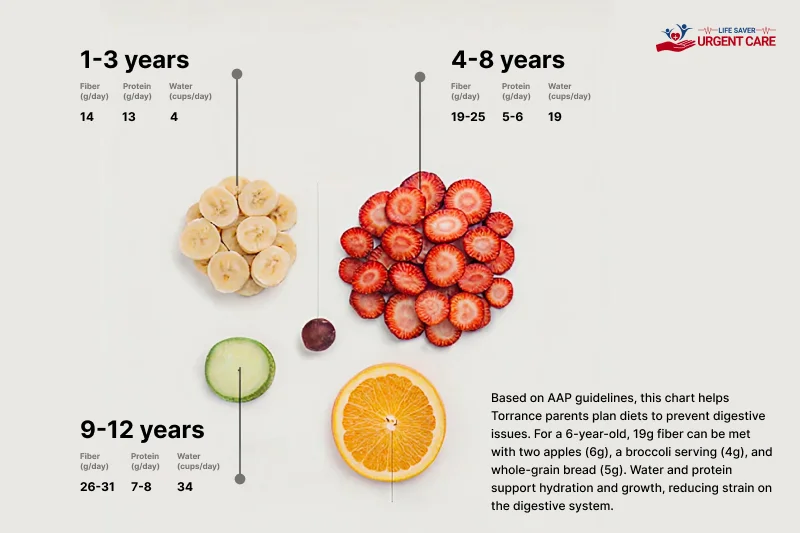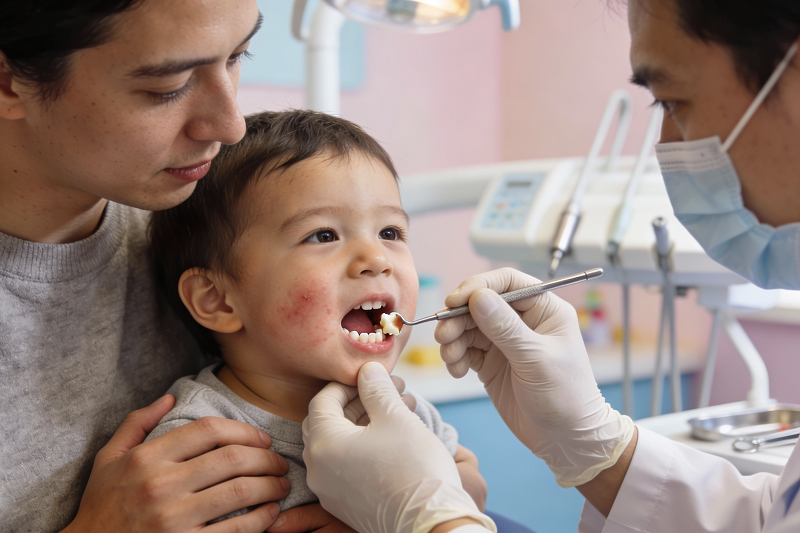Imagine it’s a sunny Saturday in Torrance, CA, and your child is hunched over, clutching their tummy after a fun morning at Wilson Park.
As a parent, you’re left wondering: Is this just a fleeting stomachache, or could it be something more serious, such as constipation, diarrhea, or food intolerance?
Pediatric digestive issues are common, affecting children from infants to teens, and can disrupt everything from school to playtime. Left unchecked, these problems can lead to dehydration, poor growth, or chronic discomfort, worrying any parent. Fortunately, Urgent Care Torrance, Life Saver offers expert diagnostics and personalized care to keep your child healthy and active.
This comprehensive guide dives deep into the symptoms, causes, home remedies, and urgent care solutions for common digestive issues like constipation, diarrhea, GERD, and lactose intolerance. Packed with practical advice, nutritional charts, and meal ideas rooted in California’s vibrant food scene, this article equips Torrance families with evidence-based strategies to manage and prevent digestive concerns.
Whether your toddler is picky about veggies or your teen is navigating school lunches, we’ll show you how to support their digestive health, ensuring they thrive in Torrance’s lively coastal community.
Table of Contents
ToggleUnderstanding Pediatric Digestive Issues:
Children’s digestive systems are still maturing, making them prone to issues like constipation, diarrhea, GERD, or food intolerances. In Torrance, where kids lead active lives, playing soccer at Entradero Park, biking along the Strand, or attending school events, these problems can derail routines.
According to the Centers for Disease Control and Prevention (CDC), about 9% of hospitalizations in children under 5 are due to diarrhea-related dehydration, highlighting the prevalence of digestive concerns.

The North American Society for Pediatric Gastroenterology, Hepatology and Nutrition (NASPGHAN) reports that functional constipation accounts for 10–25% of pediatric gastroenterology visits, often linked to low-fiber diets common in urban areas like Torrance. Local factors, such as reliance on processed snacks (think chips or sugary drinks at school) or irregular meal schedules due to busy family lives, exacerbate these issues. Torrance’s coastal humidity can also increase dehydration risks, impacting digestion.
Early intervention is critical to prevent complications like nutrient deficiencies, growth delays, or chronic pain.
For example, untreated constipation can lead to stool withholding, causing emotional distress as kids avoid painful bowel movements. Undiagnosed food intolerances may result in recurring discomfort, affecting focus at school or energy during sports.
Life Saver Urgent Care in Torrance offers walk-in diagnostics, including ultrasounds and lab tests, to pinpoint causes quickly, ensuring kids return to their active lifestyles. By addressing these issues early, parents can avoid long-term health risks, reduce the need for invasive treatments, and keep their children healthy in Torrance’s vibrant community. This guide will help you recognize symptoms, manage them at home, and know when to seek professional care.
3. Common Pediatric Digestive Issues
Pediatric digestive issues range from temporary discomfort to chronic conditions requiring medical attention. The most common include constipation, diarrhea, gastroesophageal reflux disease (GERD), lactose intolerance, and less frequent conditions like celiac disease or irritable bowel syndrome (IBS).
These issues are influenced by Torrance’s dietary habits, such as access to diverse foods at local eateries or reliance on quick, processed meals. Recognizing symptoms early allows parents to act swiftly, whether through home remedies or professional care at Urgent Care Torrance.
Below, we detail the symptoms and causes of these conditions, helping Torrance families identify when to manage at home or seek expert help to keep kids thriving.
3.1 Constipation
Symptoms: Infrequent stools (less than three times weekly), hard or painful stools, abdominal bloating, or discomfort during bowel movements. Children may avoid toileting due to pain, worsening the cycle, and show irritability or reluctance to eat.
Causes:
Low fiber intake, often from processed snacks like chips or cookies popular in Torrance schools; dehydration, worsened by coastal heat; or behavioral factors like stress or toilet aversion (e.g., avoiding school restrooms).
NASPGHAN notes that 10–25% of pediatric gastroenterology visits are for constipation, with dietary factors as a primary driver. In Torrance, kids may skip fiber-rich foods like apples (3g fiber per fruit) for convenience items, while busy schedules disrupt regular bathroom routines.
For example, a Torrance kindergartner might refuse veggies, leading to hard stools, while a preteen juggling homework and sports may skip water, exacerbating constipation. Chronic cases can cause anal fissures or emotional distress, impacting school performance. Parents can monitor for signs like strain or reduced appetite, addressing them early to prevent complications.
Urgent Care in Torrance offers stool tests to rule out underlying issues like blockages, providing laxatives or dietary plans to restore regular bowel movements, ensuring kids return to playdates or soccer practice quickly.
3.2 Diarrhea
Symptoms: Frequent, loose, or watery stools; abdominal cramps; dehydration signs like dry lips, sunken eyes, or lethargy. Severe cases may include fever or reduced urination, signaling urgent care needs. **Causes**: Viral infections (e.g., rotavirus), bacterial infections from contaminated food, or food sensitivities like lactose intolerance. The World Health Organization (WHO) reports 525,000 annual global deaths in children under 5 from diarrhea, with dehydration as the primary risk. In Torrance, shared snacks at playgrounds, school potlucks, or beach picnics can spread infections, while coastal outings may expose kids to bacteria in water or improperly handled food.
A Torrance toddler might develop diarrhea after a viral infection at daycare, while a school-age child could react to a new food like dairy-rich pizza. Rapid intervention prevents dehydration, which the CDC cites as a leading cause of pediatric hospitalizations (9% of cases in kids under 5).
Urgent Care in Torrance uses rapid stool tests to identify pathogens like bacteria or parasites, offering rehydration fluids and dietary guidance to restore health. For example, a child with viral diarrhea might receive oral rehydration solutions (ORS) and a bland diet plan, ensuring a swift recovery.
3.3 GERD (Gastroesophageal Reflux Disease)
Symptoms: Heartburn, regurgitation, vomiting after meals, or fussiness in infants. Older children may report chest discomfort, difficulty swallowing, or a sour taste in the mouth.
Causes: Immature digestive tracts in infants, overeating, or trigger foods like citrus, tomatoes, or spicy dishes are common in Torrance’s diverse restaurants. A 2023 study in the *Journal of Pediatric Gastroenterology and Nutrition* found that 20–30% of infants improve with non-pharmacological measures like smaller, frequent feedings. Stress, obesity, or lying down after meals can worsen symptoms.
For instance, a Torrance preschooler might experience GERD after eating acidic snacks like oranges, abundant in California’s markets. Chronic GERD can irritate the esophagus, causing discomfort or poor weight gain in infants.
Parents should watch for frequent spitting up or refusal to eat, seeking care if symptoms persist. Urgent Care in Torrance offers ultrasounds to assess digestive function and provides feeding advice, like upright positioning, to ease symptoms and prevent complications.
3.4 Lactose Intolerance
Symptom:
Bloating, gas, diarrhea, or abdominal pain within 30 minutes to 2 hours after dairy consumption, such as milk or ice cream.
Causes:
Reduced lactase enzyme production, often after age 2, with higher prevalence (up to 70%) in ethnic groups like Asian or African ancestry, common in Torrance’s diverse population, per the National Institute of Diabetes and Digestive and Kidney Diseases (NIDDK). Dairy-heavy diets, including California’s cheese or yogurt, can trigger symptoms if not managed properly.
A teen might notice bloating after a milkshake from a local café, signaling lactose intolerance. Early identification prevents chronic discomfort or nutritional gaps, as dairy is a key calcium source. Urgent Care provides lactose breath hydrogen tests to confirm the condition, offering dietary counseling to incorporate lactose-free alternatives like almond milk, ensuring kids meet nutritional needs without symptoms.
Less common conditions like celiac disease (gluten sensitivity), irritable bowel syndrome (IBS), or food allergies can mimic digestive issues, causing bloating, abdominal pain, or irregular stools. Celiac disease affects about 1% of children, per NASPGHAN, and may be triggered by gluten-rich foods in Torrance’s bakeries, like bagels or pizza. IBS or allergies (e.g., to peanuts or shellfish) require specialized diagnostics to differentiate from routine concerns. Urgent Care in Torrance uses blood work or stool tests to identify these conditions, ensuring accurate treatment to prevent long-term complications like malnutrition or chronic pain.
4. When to Seek Professional Help
Not every tummy ache warrants a doctor’s visit, but certain symptoms demand immediate attention to prevent serious complications.
Red flags include: –
Blood in stool or vomit: May indicate infections, ulcers, or celiac disease.
Severe abdominal pain: Lasting over an hour, suggesting blockages or appendicitis.
Dehydration signs: Sunken eyes, dry mouth, no tears, or lethargy, critical in cases of diarrhea.
Weight loss or failure to thrive: Pointing to chronic issues like food intolerance or IBS.
Urgent Care in Torrance offers walk-in diagnostics tailored for kids, including ultrasounds to detect intestinal blockages, stool tests for infections or parasites, and blood work for inflammation or celiac markers.
For example, a child with persistent diarrhea might receive a rapid test to identify a bacterial cause, followed by rehydration therapy with ORS, which WHO notes reduces diarrhea mortality by 93%. The CDC highlights that 9% of pediatric hospitalizations stem from dehydration, making timely care essential.
Urgent care’s affordability (co-pays as low as $20–$50 for insured families) and extended hours suit Torrance’s busy schedules, ensuring kids miss fewer school days or sports practices. For instance, a Torrance parent can bring their child after school for an ultrasound to assess GERD, receiving a treatment plan the same day. Prompt intervention prevents complications like anal fissures from constipation or esophageal damage from GERD, keeping kids active in Torrance’s vibrant community
5. Home Remedies:
Parents can often manage mild digestive issues at home before seeking professional care, using strategies tailored to each condition. These remedies leverage Torrance’s accessible resources, like fresh produce from local markets, to alleviate symptoms and promote recovery.
Below, we outline specific approaches for constipation, diarrhea, GERD, and lactose intolerance, plus general tips to support healthy digestion, ensuring kids stay comfortable and active.
5.1 Constipation:
Hydration: Offer 4–6 cups of water daily for ages 4–8, per American Academy of Pediatrics (AAP) guidelines, to soften stools. Torrance’s coastal heat increases dehydration risks, especially during outdoor play.
Fiber: Serve California-grown prunes (3g fiber per serving) or apples from Torrance Farmers’ Market. The California Department of Public Health (CDPH) notes that kids consume only 10–15g fiber daily, below the 19–25g recommended for ages 4–8.
Exercise: Encourage 30–60 minutes of activity, like biking at Entradero Park or jumping at Sky Zone Torrance, to stimulate bowel movements. For a Torrance toddler, a smoothie with prunes and spinach can ease constipation, while school-age kids benefit from active play after meals. Parents can offer water bottles during outings to maintain hydration, preventing hard stools.
5.2 Diarrhea:
Rehydration:
Use oral rehydration solutions (ORS) like Pedialyte, offering small sips frequently. WHO states ORS reduces diarrhea mortality by 93%.
BRAT Diet: Bananas (1g fiber), rice, applesauce, and toast soothe the stomach. Torrance’s markets offer ripe bananas for easy digestion.
Rest: Avoid sugary snacks or juices, which worsen diarrhea, and limit activity to conserve energy. A kindergartner with diarrhea from a virus can recover with ORS and a bland diet, preventing dehydration risks noted by the CDC. Parents should monitor for dry lips or lethargy, seeking urgent care if symptoms persist.
5.3 GERD -
Smaller Meals: Divide meals into 5–6 small portions daily to reduce reflux pressure on the stomach. –
Upright Positioning: Keep infants upright for 30 minutes post-feeding, per JPGN recommendations, to minimize regurgitation.
Avoid Triggers: Skip acidic foods like oranges or tomatoes, common in Torrance’s food scene, to prevent irritation. An infant with GERD benefits from smaller, frequent feedings and avoiding citrus juices, while older kids can skip spicy tacos to ease symptoms.
5.4 Lactose Intolerance
Lactose-Free Options: Use almond milk or lactose-free yogurt, available at Torrance stores like Whole Foods or Sprouts.
Enzyme Supplements: Over-the-counter lactase pills help digest dairy, reducing bloating or gas.
Monitor Intake: Limit cheese or ice cream to small servings to avoid symptoms. A Torrance teen can switch to lactose-free milkshakes from local cafés, preventing discomfort after dairy-heavy meals, with guidance from urgent care.
5.5 General Tips
Create a calm eating environment, free from screens or distractions, to aid digestion and reduce stress-related symptoms. Control portions to prevent overeating, which can overwhelm young digestive systems. Keep a symptom diary to track triggers (e.g., dairy or gluten), aid discussions with providers. These habits, easy to implement at homes, promote consistent digestion and help parents identify when professional care is needed.
6. Dietary Adjustments:
Nutrition is the foundation of managing and preventing pediatric digestive issues. Fiber, probiotics, and balanced nutrients reduce symptoms and support gut health. Torrance’s access to California’s abundant produce, like broccoli and berries from the Torrance Farmers’ Market, makes this achievable.
The CDPH notes that California children consume only 10–15g of fiber daily, below the 19–25g recommended for ages 4–8, increasing risks of constipation. By incorporating local foods and balanced meals, parents can ensure their kids’ digestive systems stay healthy, reducing the need for frequent medical visits.
6.1 Age-Appropriate Meal Ideas
Toddlers (1–3 years): Mashed avocado (10g fiber per fruit) on whole-grain toast, paired with diluted apple juice for hydration. Offer a banana-oat muffin, soft and fiber-rich, as a snack.
A toddler might enjoy mashed sweet potatoes (4g fiber) with a sprinkle of cinnamon, using local produce.
Preschoolers (4–5 years): Berry smoothies with California strawberries, spinach (4g fiber per cup), and lactose-free yogurt for probiotics. Blend with almond milk for a creamy, gut-friendly treat. Serve carrot sticks (2g fiber) with hummus for a crunchy snack.
School-Age Kids: Whole-grain wraps with grilled chicken, broccoli (4g fiber), and hummus, perfect for school lunches. Pair with sliced apples (3g fiber) from Torrance Farmers’ Market or a quinoa salad with local zucchini. These meals meet AAP’s fiber goals (14g/1000 calories) and use Torrance’s fresh produce to support digestion. For example, a family can shop at Wilson Park’s market for spinach and berries, creating kid-friendly, nutrient-dense meals that prevent constipation and promote gut health.
6.2 Nutritional Chart

Based on AAP guidelines, this chart helps Torrance parents plan diets to prevent digestive issues.
For a 6-year-old, 19g fiber can be met with two apples (6g), a broccoli serving (4g), and whole-grain bread (5g). Water and protein support hydration and growth, reducing strain on the digestive system.
7. Urgent Care Solutions
Urgent Care in Torrance provides comprehensive solutions for pediatric digestive issues, using state-of-the-art diagnostics and tailored treatments.
On-site tools include: –
Ultrasounds: Non-invasive imaging to detect blockages or inflammation, safe for kids with severe constipation or GERD.
Stool Tests: Identify infections (e.g., rotavirus, bacteria) or parasites causing diarrhea, ensuring precise treatment.
Blood Work: Detect markers of celiac disease, inflammation, or lactose intolerance via breath tests. Treatments may include laxatives (e.g., polyethylene glycol) for constipation, rehydration fluids for diarrhea, or acid reducers for GERD, aligned with NASPGHAN guidelines.
For example, a child with persistent bloating might undergo a lactose breath test, confirming intolerance, followed by a lactose-free diet plan.
Follow-up care includes dietary counseling to avoid trigger foods and lifestyle advice to maintain gut health. Urgent Care Torrance offers affordable visits (co-pays $20–$50 for insured families) and extended hours, ideal for Torrance’s busy parents. A child with diarrhea can be seen after school, receiving rapid testing and ORS, ensuring a quick return to activities like dance class or homework.
8. Prevention Strategies
Preventing digestive issues keeps Torrance kids thriving in school and play.
Key strategies include: –
Hydration: Encourage 5–8 cups of water daily, vital in Torrance’s coastal climate where heat increases dehydration risks. Offer reusable water bottles during outings to Columbia Park or beach trips.
Fiber-Rich Diet: Use California produce like broccoli (4g fiber per cup), berries, or avocados from Torrance Farmers’ Market. The CDPH notes kids consume only 10–15g fiber daily, below the 19–25g needed for ages 4–8, increasing constipation risks.
Lifestyle: Maintain consistent mealtimes to regulate digestion. Encourage 60 minutes of daily activity, like soccer at Torrance High or skateboarding at McMaster Park, to stimulate bowel function.
Parental Education: Track symptoms in a diary (e.g., bloating after dairy) and consult Urgent Care Torrance, for screenings to catch issues early.
For example, plan fiber-rich dinners with local spinach and quinoa in your family diet, reducing constipation risks. These habits foster long-term digestive health, keeping kids active and happy.
9. Torrance-Specific Resources:
Torrance’s resources make managing pediatric digestive health achievable. The Torrance Farmers’ Market (Wilson Park, Tuesdays/Saturdays) offers fiber-rich foods like apples (3g fiber), spinach (4g fiber), and avocados (10g fiber), perfect for kid-friendly meals.
Community programs, like nutrition workshops at Torrance schools, promote healthy eating habits. Urgent Care supports families with walk-in diagnostics, stool tests, and dietary counseling, ensuring kids stay healthy.
For related concerns, such as Minor Injuries and Rehabilitation, urgent care provides comprehensive care for kids in Torrance, addressing sprains or cuts from sports or play, ensuring holistic wellness. These local resources empower parents to prevent and manage digestive issues effectively.
10.Conclusion:
Pediatric digestive issues, from constipation to lactose intolerance, can challenge Torrance families, but proactive care makes all the difference. By recognizing symptoms like bloating or infrequent stools, using home remedies like fiber-rich diets, and seeking professional help when needed, parents can keep their kids healthy. Torrance’s access to California’s fresh produce, like broccoli and berries from the Farmers’ Market, supports digestion, while Life Saver Urgent Care’s diagnostics,ultrasounds, stool tests, and blood work ensure quick, accurate treatment. With affordable visits and extended hours serving as an extended trusted partner for Torrance parents, helping kids return to school, sports, and play without delay.
Make an appointment today, visit us to create a personalized plan for your child’s digestive health, ensuring they thrive in Torrance’s vibrant coastal community.
FAQ’s
Kids often face constipation (hard stools), diarrhea (loose stools), GERD (heartburn), and lactose intolerance (bloating after dairy). Less common issues include food allergies or celiac disease, causing tummy pain or irregular stools.
Seek help for blood in stool, severe pain over an hour, dehydration (dry mouth, no tears), or weight loss. These signs suggest serious issues needing quick attention to avoid worsening.
Give 4–6 cups of water daily and fiber-rich foods like apples or prunes. Encourage playtime, like park visits, to boost bowel movements. See a doctor if it persists.
Offer rehydration drinks like Pedialyte in small sips. Use bananas, rice, applesauce, or toast. Avoid sugary drinks. Seek urgent care for dehydration signs like dry lips.
Bloating, gas, or diarrhea after milk or ice cream may mean lactose intolerance. Try lactose-free milk or enzyme pills. See a doctor if symptoms continue.
Yes, offer fiber-rich foods like broccoli or berries and 5–8 cups of water daily. Regular meals and playtime help. Track symptoms to spot food triggers early.
Doctors use ultrasounds for tummy blockages, stool tests for infections, or blood tests for allergies. These help find the cause of pain or irregular stools quickly.



